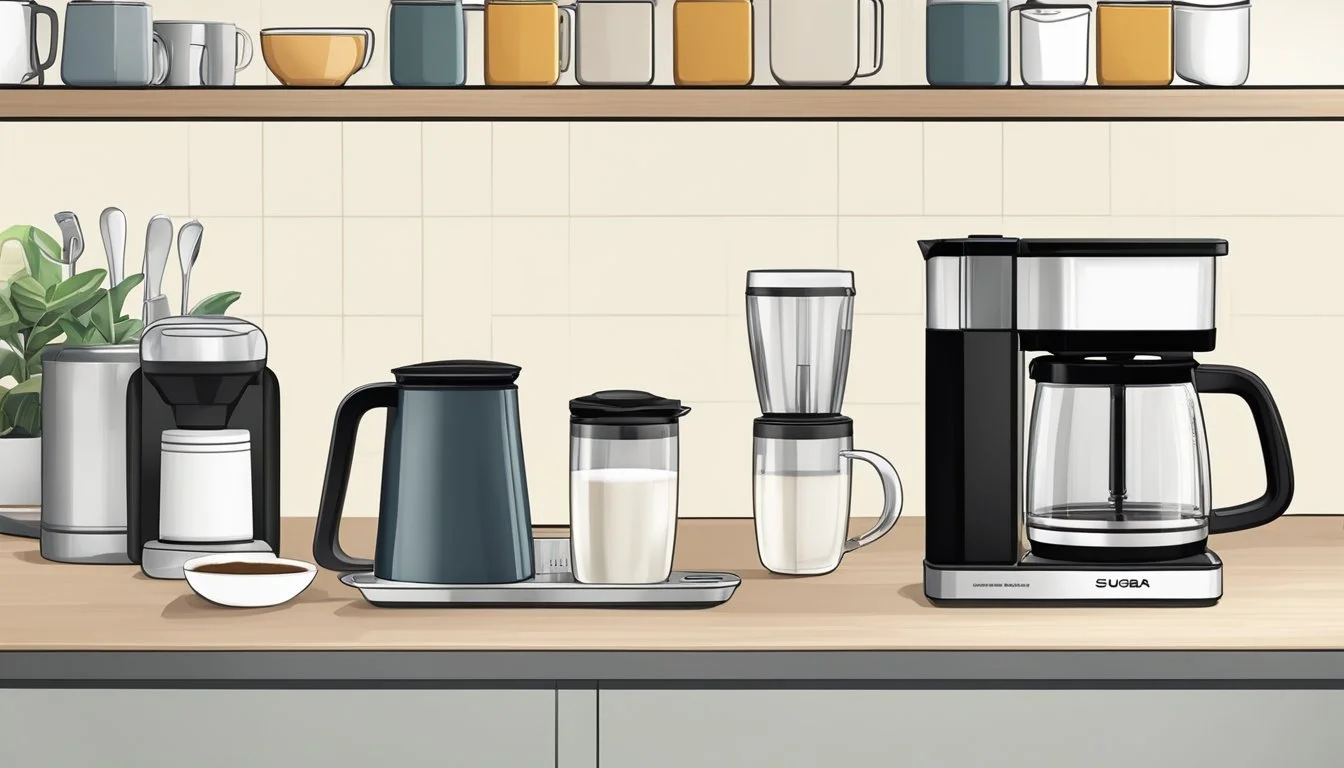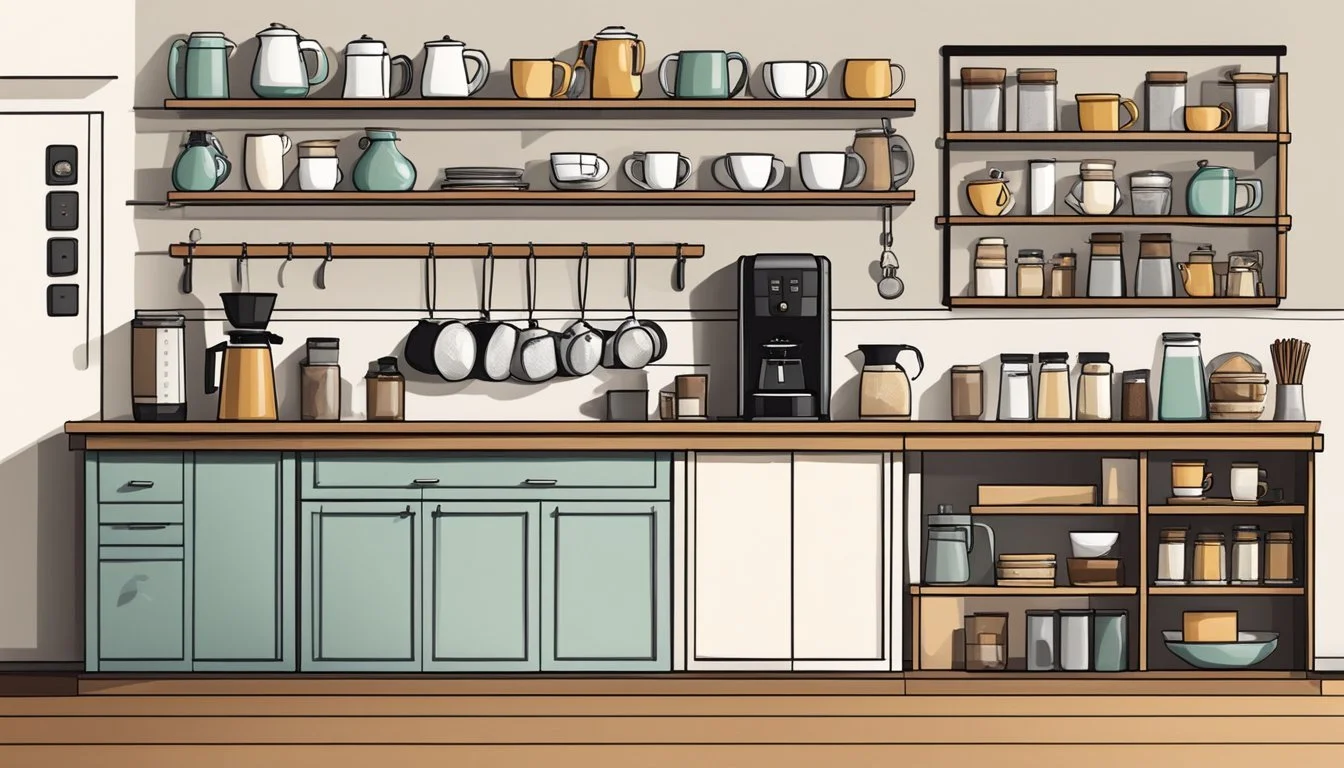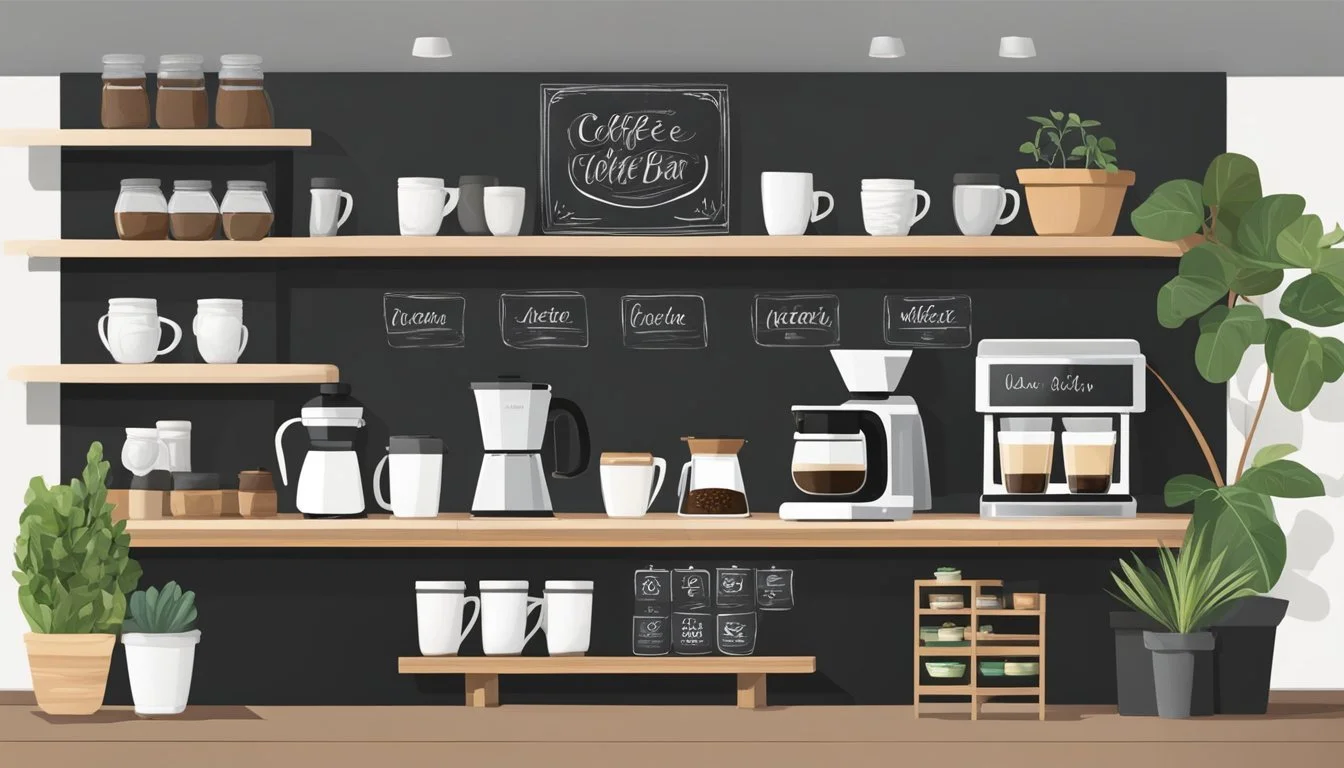How to Create an Organized Kitchen Coffee Bar
Essentials for Efficiency
Designing an organized kitchen coffee bar can enhance both the aesthetics and functionality of one's home. It transforms a simple corner into a dedicated space for brewing and enjoying coffee, streamlining the morning routine. An effectively designed coffee bar consolidates all necessary items in one area, reducing clutter and saving time. This setup not only accommodates coffee essentials like beans, filters, and mugs but also makes an inviting spot for residents and guests alike.
Incorporating elements like a sideboard or open shelving can elevate a coffee station from a mere countertop collection to a focal point in a kitchen or dining area. Drawers or cabinets within a sideboard offer discreet storage for extra supplies, keeping the area neat. Open shelves, on the other hand, provide easy access while displaying decorative mugs and coffee paraphernalia which can contribute to the overall charm of the space.
Optimizing a coffee bar involves more than just efficient storage; it's about creating a personalized experience. Whether one opts for a built-in cabinet that blends with the kitchen's aesthetic or transforms an underused appliance garage into a cozy nook, the goal is to tailor the coffee bar to fit both the functional needs and the style of the home. From mug trees that keep cups within arm's reach to art that adds a personal touch, these details round out the creation of an organized and inviting kitchen coffee bar.
Designing Your Kitchen Coffee Bar
When designing a kitchen coffee bar, one should consider both functionality and aesthetic appeal. Selecting the right furniture is crucial; a sideboard or a nook in the kitchen can serve as the foundation for the coffee bar. For a cohesive look, the choice of furniture should complement the overall kitchen design.
Determining a color scheme is also essential. Neutral colors tend to blend seamlessly with most decors, while bold hues can create a striking focal point. The selected color palette should reflect the style and theme of the home coffee bar.
A well-organized display is key to a functional coffee bar. Utilize open shelving or a mug tree to keep mugs accessible yet orderly. This approach not only saves cabinet space but also allows one to showcase their favorite mugs as part of the decor.
Incorporating a variety of coffee bar ideas into the design can enhance the space. Consider the following:
Drawers for coffee pods and tea bags
Shelves for syrups and toppings
Design Enhancements:
Artwork or small decorative items to personalize the space
A small bowl filled with fresh fruit or seasonal decor for visual interest
By focusing on a design that blends storage and display, one can create a coffee bar that is both practical and inviting. Remember to arrange the most frequently used items within easy reach to streamline the coffee-making process.
Selecting the Right Location
The foundation of a well-organized kitchen coffee bar is choosing an optimal location that considers both layout and efficiency within the kitchen space. This ensures that the coffee station is both functional and integrated smoothly into the daily flow of kitchen activities.
Assessing Kitchen Layout
When selecting the location for a coffee bar, one must scrutinize the existing kitchen layout. Key considerations include:
Ease of Access: Select a spot that is readily accessible but not in the way of high-traffic kitchen zones.
Proximity to Outlets: Ensure the location is near electrical outlets for coffee makers and other appliances.
Visibility: Choose a location that is visible and adds to the kitchen's aesthetic without creating a cluttered look.
For small kitchens, one should look for underutilized spaces, such as corners or ends of counters, that can be transformed into an efficient coffee station. Vertical space utilization with wall-mounted shelves can effectively increase counter space while maintaining a clutter-free environment.
Optimizing Space Utilization
Space optimization revolves around effectively using available areas without contributing to clutter. It's important to:
Dedicate Counter Space: Reserve an area of the counter specifically for coffee-related items to create a designated zone.
Employ Vertical Space: Use hanging racks or floating shelves to make the most of vertical space above the counter.
Organize with Drawers and Cabinets: If space permits, designate drawers or cabinets near the coffee bar for supplies to keep countertops clear.
For small spaces, space-saving solutions like fold-out tables or compact rolling carts can serve as additional counter space when needed. Choosing a location that allows for these modifications can redefine the functionality of a space-constrained kitchen.
Essential Equipment
To create an organized kitchen coffee bar, one needs to focus on essential equipment selection. This includes choosing the right coffee maker, finding a suitable coffee grinder, and rounding out the setup with additional coffee tools that enhance the brewing process.
Choosing a Coffee Maker
The coffee maker is the centerpiece of any coffee bar. Consumers should consider their preferred type of coffee when selecting a maker.
Drip Coffee Makers: Ideal for brewing large quantities of coffee. They are user-friendly and a common choice for many households.
Espresso Machines: For those who prefer a robust flavor, espresso machines deliver a potent shot of coffee and usually have options for making lattes and cappuccinos.
French Press: This manual method allows for full control over brewing time and intensity, suitable for those who like to customize each cup.
Keurigs: Perfect for single servings and convenience, Keurig machines provide a quick coffee fix with a variety of pod flavors.
Coffee Grinder Selection
Freshly ground beans are key to a flavorful cup of coffee, and a grinder is a crucial addition to the coffee bar.
Blade Grinders: Cost-effective and compact, though may produce uneven grounds.
Burr Grinders: Offer a consistent grind size, crucial for flavor extraction, with adjustable settings to cater to different brewing methods.
Additional Coffee Tools
The coffee experience is defined by not just the machine and grinder but also the array of accessories at one's disposal.
Milk Frother: For espresso machine owners or those who enjoy milk-based coffee beverages, a milk frother is indispensable for that creamy finish.
Spoons and Stirrers: Necessary for mixing flavors and sugars into the coffee.
Kettle: For manual brewing methods like French press or pour-over, a good kettle with a precise pouring spout is essential.
Tray: Keeping a tray handy allows one to organize small accessories and transport drinks with ease.
Coffee and Accessory Storage
Creating an efficient kitchen coffee bar involves meticulous organization of coffee supplies and accessories. It's essential to utilize effective storage solutions that keep items easily accessible while maintaining a clutter-free space.
Organizing Coffee Supplies
Coffee Beans and Grounds: Coffee beans and grounds should be stored in airtight canisters to maintain freshness. Canisters not only preserve flavor but also contribute to a tidy countertop. Organizers recommend using clear containers for easy identification of contents.
Sugar and Sweeteners: Keep sugar, sweeteners, and syrups in labeled containers or baskets, which can be neatly arranged on shelves or in cabinets. This not only ensures they are conveniently within reach but also prevents spills and clutter.
Coffee Pods: For those using coffee pods, drawer organizers are ideal. They allow for sorting by flavor or brand and can be easily placed under the coffee machine to save space.
Storage Solutions
Shelves and Cabinets: Floating shelves or cabinets above the coffee bar can hold mugs and larger canisters, maximizing the use of vertical space. Ensure these storage areas remain within arm’s reach to maintain functionality.
Drawers and Baskets: Utilize drawers for storing tea bags and coffee-related utensils. Baskets can offer a decorative touch to open shelving units while keeping items like napkins and stirrers organized.
Countertop Storage: For those with limited space, a minimalistic approach to storage on the countertop can involve a mug tree or a small basket for frequently used items, ensuring essentials are at hand without overcrowding the surface.
By employing these storage ideas, a kitchen coffee bar can be both aesthetically pleasing and highly practical.
Functional Decor and Artwork
Creating an organized kitchen coffee bar incorporates both functionality and style. Thoughtfully selected decor and personalized artwork can elevate the coffee-making experience while enhancing the overall aesthetic of the space.
Selecting Decor Pieces
When choosing decor for a kitchen coffee bar, consider pieces that meld practicality with visual appeal. Floating shelves not only offer additional storage but also present a platform for displaying coffee-related decor. Opt for a theme that complements the kitchen's style, whether it be vintage, luxury, or DIY. Utilizing a repurposed bar cart or an old dresser from a thrift store can add character and serve as a focal point. Below are considerations for selecting functional decor:
Storage: Keep cups, sugars, and stirrers within reach.
Appeal: Choose items that reflect the coffee bar's theme.
Implementing Art and Style
Artwork enriches the coffee bar's ambiance and injects personality. It should synergize with the chosen theme and color scheme. Incorporating vintage signs or antique coffee grinders can lend old-world charm. Alternatively, modern art pieces or stylish DIY creations add a contemporary touch. Here are key points for integrating art:
Wall Art: Place art pieces at eye level for visual interest.
DIY Touch: Personalize the area with handmade items for a unique twist.
Setting Up for Efficiency and Convenience
Creating an efficient and convenient kitchen coffee bar involves smart layout design and a focus on ease of cleaning and maintenance. This ensures quick access to morning coffee and a clutter-free space.
Layout for Easy Access
The layout of a kitchen coffee bar should prioritize functional access to everything one needs for their morning coffee. One should choose a location within the kitchen that is easily accessible but away from high-traffic areas to avoid congestion. It's crucial to have coffee-making essentials within reach to streamline the process. Here's a suggested layout:
Coffee Machine: Front and center on the countertop.
Mugs: On a mug tree or open shelving above or beside the machine.
Coffee & Essentials: Store coffee beans, sugar, and other essentials in clear, labeled containers to the side of the machine.
Accessories: Place spoons, stirrers, and napkins in a drawer or a compartmentalized organizer close by.
Cleaning and Maintenance
An organized coffee bar simplifies cleaning and maintenance. Keeping the space clutter-free is not only inviting but also functional, as it makes cleanup quicker and more efficient. Here's a brief guide on maintaining a tidy coffee bar:
Daily Maintenance: Wipe down surfaces and the coffee machine after each use.
Organizers: Use easy-to-clean trays for spills and small organizers for accessories to prevent clutter.
Deep Cleaning: Allocate a regular schedule for deep cleaning, including descaling the coffee machine and washing any fabric elements like mats or towels.
By incorporating these elements into the design, one ensures their kitchen coffee bar is a model of efficiency and convenience.
Personalizing Your Coffee Station
When setting up a home coffee station, incorporating personal touches and creating an inviting atmosphere can transform a simple nook into a cherished part of one's daily ritual.
Adding Personal Touches
One's coffee station should reflect their personality and style through the details that make it uniquely theirs. Mug collections are a prime example; they can be displayed on hooks or a mug tree, making for both an aesthetic and functional element of the station. Using a tray to corral items like sugar dishes, creamers, and spoons not only keeps things organized but also allows for easy customization. Incorporating DIY elements such as hand-painted labels or a small chalkboard can add a personal touch, providing a space for messages or to highlight the coffee selection of the day.
Display Options for Mugs:
Mug tree
Hooks under cabinets
Open shelving
DIY Touches:
Custom labels for containers
Chalkboard for daily brews or notes
Creating An Inviting Atmosphere
A coffee station should not only reflect one's style but also invite them to enjoy their coffee-making experience. Opt for warm, cozy colors and soft lighting to create a welcoming vibe. Adding elements like a small plant or decorative pieces that match one's home decor can tie the coffee nook into the overall feel of the house. Comfort can be enhanced with easy access to all items needed for the perfect cup. Clear, labeled jars for different coffee blends and a selection of teas ensure everything is at hand, maintaining a tidy and inviting environment.
Atmosphere Enhancers:
Soft, warm lighting
Complementary colors and decor
Plants or decorative items
Additional Features and Ideas
Creating an organized kitchen coffee bar involves more than just a good coffee maker. It's about equipping the space with features that enhance functionality and cater to personal preferences.
Advanced Coffee Bar Equipment
For those looking to replicate a professional coffee shop experience, investing in advanced coffee bar equipment is essential. An espresso machine with a built-in milk frother elevates one's barista skills, enabling the creation of a variety of coffee-based drinks from lattes to cappuccinos. Here's a condensed list of equipment one might consider:
Espresso machine: A cornerstone for any at-home coffee bar, providing the base for most specialty coffees.
Milk frother: For achieving that perfect foam for lattes and other milk-based drinks.
Coffee grinder: Freshly grinding beans can significantly improve the taste of coffee.
Digital scale: Precision leads to consistency in coffee brewing, which a scale can help achieve.
Multifunctional Furniture Pieces
Optimizing space is key, and multifunctional furniture pieces contribute both to organization and space efficiency. Furniture such as a bar cart or rolling cart can serve as a mobile coffee station, easily moved when entertaining guests or to make more room. A built-in hutch or pantry near the coffee bar allows for convenient storage of beans, teas, and other supplies. For a unique twist, one might repurpose an old dresser into a coffee bar, combining storage and surface area in a single piece of furniture. Here are some furniture ideas to consider:
Bar cart/rolling cart: Offers mobility and an open design that can be utilized for both storage and display.
Built-in features: A dedicated nook or pantry beside the coffee bar provides ample storage and easy access.
Repurposed furniture: An old dresser or hutch can be creatively transformed into a functional and stylish coffee bar.
When integrating these additional features into a kitchen coffee bar, one should consider the overall kitchen layout, ensuring that there is a harmony between the coffee bar and elements such as the sink or dining area, enhancing both aesthetics and function.
Tips for a Clutter-Free Space
When creating an organized kitchen coffee bar, maintaining a clutter-free environment is essential. Proper storage solutions and thoughtful organization can transform a cluttered corner into a streamlined coffee station.
Label Everything: Clearly label containers and shelves. This not only helps in identifying contents but also contributes to maintaining order.
Containers Content Canister 1 Coffee beans Canister 2 Sugar Jar 1 Stirrers
Use Vertical Space: Install shelves or hanging racks to store cups, mugs, and accessories. This makes use of vertical space and keeps the counter clear.
Minimize on the Counter: Avoid keeping all equipment out. Limit the counter to a coffee machine and most-used items.
Consolidate Containers: Choose a few large containers over many small ones to reduce visual clutter. Store similar items like tea bags and coffee pods together.
Utilize Drawer Dividers: For items stored in drawers, use dividers to separate and organize accessories such as spoons and napkins.
Regular Decluttering: Set a routine to go through the coffee bar to remove and re-home items that don't belong.
Remember that a clutter-free space is not just about aesthetics; it promotes efficiency and enjoyment in your daily coffee ritual. By incorporating these tips, anyone can ensure their kitchen coffee bar remains clean, tidy, and inviting.






